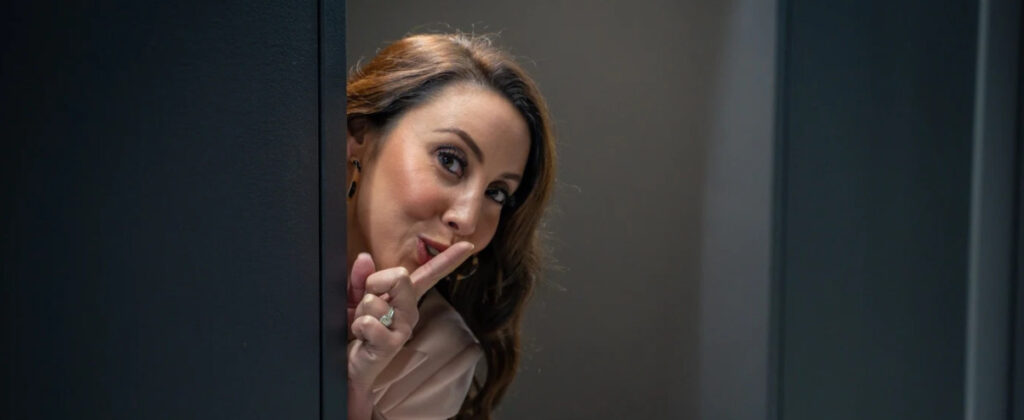LOUISE GILBERT
Founder & Director

Announcing Teamflix: Your Ultimate Team Development Hub! It’s like Netflix … for teams! Watch here

It’s that time of year again. It’s coming up to Valentine’s Day, and our supermarket aisles are filled with all its cutesy trappings. You know the drill: teddy bears, red-and-pink card displays, roses, chocolates. Things that smell nice, or taste good, or even sparkle a little… and all in the name of a little thing called love.
There’s often a bit of a negative energy around this celebration. You might even yourself be a member of an “anti-Valentine’s Day” squad who will point out that profit-seeking restaurants hike up their prices, and that the paraphernalia has a tendency to be on the tacky side. I’ve also been party on more than one occasion to a rumour that the day in question was actually invented by Hallmark in the mid-20th century to increase card sales (fun fact: according to history.com, in the UK and France, Valentine greetings go as far back as the year 1400 – now try telling me it’s a new concept!).
I, for one, am a bit slushy when it comes to Valentine’s Day. I love waking up on the 14th February and exchanging cards and kisses with my husband, Josh, and having a romantic meal in the evening. It’s a tangible way showing our appreciation for one another in a world that’s otherwise so often swamped by our roles as parents, our work, and housework!
However, there are a couple of poignant points at the centre of the argument to ditch Valentine’s Day that I’m going to chat about here. The first – shout out to all the singletons! – is the fact that romantic love doesn’t look the same for every individual. And the second is that saving expressions of love for one particular calendar date, when it should be shown all year round, is problematic.
What is “love”? Baby, don’t hurt me…
Love is a feeling that humans, for the most part, are wired to seek out. When we love someone, we feel an intense rush of emotions towards that person: affection, protectiveness, warmth and respect. Love is the ultimate connection with another person. All that said: love can be painful. It can be unrequited or it can go hand-in-hand with grief. Valentine’s Day often comes with a smattering of sweet messages between couples on our news feeds, and while I maintain that social media can (and should!) be used for the greater good, this type of display isn’t always helpful to everyone who’s receiving it. So what can we do to invite into our lives a more inclusive type of love, one from which everyone can benefit?
Barbara Frederickson, American Professor of positive psychology and author of Positivity (2009) and Love 2.0 (2013) was responsible for developing a theory called the Broaden and Build Theory, which is based on the notion that the more positive emotions humans experience, the more empathetic they are and the easier they find it to establish bonds, spark creativity and strengthen well-being. In other words, positivity us better equipped for survival. They also help us navigate more difficult times in our lives, because we are better prepared to maintain perspective when things get tough. When it comes to love, Frederickson points out much of the emphasis society places on enduring, romantic love is misplaced: rather, love is an emotion that we experience in the same way we do any other – one that “can be shared several times a day with different people ranging from family members to strangers on the street”[1]. As humans, we crave love, but as Frederickson points out, possibly not in the way it’s fed to us by movies, books, and yes, Hallmark: she actually identifies it as a collection of micro-moments of “shared positivity” – warm, caring moments that can be shared with anyone we encounter.
Enter the Top 10 Positive Emotions
Frederickson identified a series of 10 positive emotions that we can share with others in order to curate our own version of happiness. In addition to love, these are made up of:
The most striking thing about this list is that when we put them in the context of their power to help us build connection, we can see that the intensity of the positive emotion is amplified when we have the opportunity to share it with others. Take interest, for example: we are naturally drawn to people who share our passions and values. Think about awe: when you’ve seen something breathtaking while travelling, it’s often made all the more special when the experience is shared.
What’s more, none of these are reserved exclusively for a romantically-involved couple. Every one of them can be shared with a family member, a friend, a colleague – and they can all be experienced in those micro-moments that Frederickson describes. As she puts it: “when one finds another that they are able to share several such moments, bonds are created, loyalty is developed and enduring relationships created.[2]”
Rethinking romance
This means that the pedestal on which love is often placed doesn’t work in isolation. It’s actually part of a web of positive emotions which all contribute to our ability as humans to build important connections.
So, I put the following question to you: what does “love” really look like in your world? Is it something that you experience on its own, with one exclusive person; or is it, rather, a feeling made up of a combination of multiple positive emotions, some of which might be better enjoyed with a different person in your life?
Despite my smushiness when it comes to Valentine’s, I agree that we should be showing love to those close to us in ways that don’t involve cards and flowers. And if we’re in relationships, we should acknowledge that not only can it be a hard day for other people, but that we are in fact capable of helping those people experience the connections that Barbara Frederickson identifies – and that it’s good for us, too.
Your Valentine’s Day challenge
That’s why I’m inviting you to take part in a challenge over this year’s season of love. It’s all about building the type of love that Frederickson describes in her research, and it goes a little like this:
For every expression of romance you share, be sure, too, to make space for the other positive emotions that ultimately help to enrich all our lives. If you can, share that positive emotion with someone else. This could include celebrating the success of a project by one of your colleagues (pride). It could be ringing up a friend to tell them a funny story (amusement) or reminiscing about something you did together (gratitude). Or it could be as simple as appreciating a sunset with a stranger on the beach (serenity/awe). And that’s not to say you should forget your significant other: if you’re in a romantic relationship, your partnership can benefit from sharing these moments together, too.
So go ahead: feel the love this Valentine’s Day. Revel in it. Go out for dinner and relish every bite. Buy someone a bunch of roses to say thanks. Invite all those positive emotions in – and take them with you into the rest of February, March, April…and beyond!
Time to share the love
At The Intime Collective, we’re all about using positive emotion to enhance relationships in work and life. Our workshops recommend skills and strategies for building better relationships in an inclusive environment, so that every team member comes away feeling energised and motivated to build more meaningful connections. If your team could benefit from an introduction to the Broaden and Build Theory and 10 positive emotions, get in touch today!
[1] https://www.pursuit-of-happiness.org/history-of-happiness/barb-fredrickson/
[2] https://www.pursuit-of-happiness.org/history-of-happiness/barb-fredrickson/

Founder & Director
